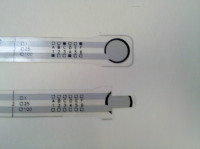Can I Trim the FlexiForce sensor?
Question: Can I Trim the FlexiForce™ Sensor?
Answer: Yes - it is possible to trim the FlexiForce sensor if the sensing area is too large or the wrong shape for your application. Additionally, trimming the sensor can be a good way to develop a proof-of-concept before investing in a customized sensor solution. However, please keep in mind that trimming the sensing area can result in less durability, potential for shorting, and less sensitivity.
 Trimmed FlexiForce sensorIf you attempt to trim the sensor, we recommend using a sharp pair of scissors to lessen the stress and/or deformation of the sensor that may occur when cutting. Once you've trimmed the sensor to the desired shape and/or size, you will want to apply a piece of tape to both sides of the sensor - this will help create a seal around the sensor keeping out dirt and debris.
Trimmed FlexiForce sensorIf you attempt to trim the sensor, we recommend using a sharp pair of scissors to lessen the stress and/or deformation of the sensor that may occur when cutting. Once you've trimmed the sensor to the desired shape and/or size, you will want to apply a piece of tape to both sides of the sensor - this will help create a seal around the sensor keeping out dirt and debris.
If you need to punch a hole in the sensing area, we recommend creating a slightly larger hole than needed, applying tape on both sides of the sensing area, and then creating another smaller hole in the center. This will create a ring of tape around the hole you've just created and help to keep the sensor sealed.
Note: Tekscan cannot warranty sensors that have been physically altered.
Link to this FAQ